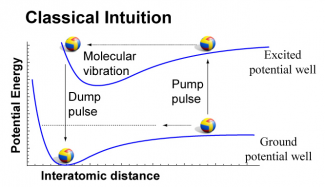Scientists anticipate that cold molecules will allow them to explore all kinds of exciting new cold-matter physics. For instance, cold molecules should be able to interact with each other over much longer distances than atoms. They often exhibit an uneven distribution of electric charge called a dipole moment. Unfortunately, the complicated structures of ordinary "warm" molecules means it is very difficult to directly cool them to very cold temperatures.
One way to create cold molecules is to use magnetic Feshbach resonances to make them from cold atoms. However, Feshbach molecules are large, loosely bound, and form in a very excited (and relatively unstable) vibrational state. To study them, scientists must figure out how to stabilize them, producing deeply bound cold polar molecules.
The solution to this problem is finding a way to precisely control the molecular dynamics of Feshbach molecules in a way that drives their transition into a stable ground state. Femtosecond frequency combs can enable this level of control, according to an analysis by research associate Avi Pe'er, graduate student Matthew Stowe, Fellow Jun Ye, and their colleagues from the University of British Columbia and the Weizmann Institute of Science.
The researchers recently completed an analysis of a new method for driving molecules from a high vibrational state (in the ground electronic state) down to the lowest vibrational state. The new method, shown schematically above, can be intuitively understood classically.
Vibrating molecules oscillate back and forth through a potential well, spending most of their time near the vibration turning points at the well's walls. As the vibration increases, the vibrating nuclei climb higher on the potential walls and start to feel the asymmetry of the potential well. For Feshbach molecules, which are at the strongest vibration possible before breaking apart, this effect is maximal so the nuclei mostly hang out near the external turning point of the potential well.
It is possible to use ultrashort laser pulses to pump Feshbach molecules into new (excited) electronic potential wells, where the nuclei of their atoms begin to vibrate in response to their new environment. If the inner turning point of the new potential well sits directly above the lowest point in the ground potential well, then another laser pulse can dump the molecule directly to the bottom of the ground well, i.e., into its ground state. The trick is timing: The dump pulse must occur when the molecule is vibrating at the inner turning point of the excited well.
In the classical picture, the pump/dump process occurs in a single step. However, on the quantum level, there can be many small pump/dump steps, as shown below. With each step, a small fraction of the molecule (i.e., its wave function) is transferred into the ground state. The molecules are gradually transferred by the cumulative effect of many laser pulse pairs, a process known as coherent accumulation. For this proccess to occur, both the pump and dump pulses must be perfectly synchronized to the quantum behavior of the molecules. This synchronization is accomplished by having both the pump and dump lasers be femtosecond frequency combs with exactly matching teeth (frequencies). Even using frequency combs, coherent accumulation requires time during which the molecules must not be disturbed by collisions. For this reason, the method is well suited for cold matter where everything happens at a snail's pace and coherence times are long.
Armed with a quantum mechanical understanding of their new method, Pe'er and his colleagues are now planning a series of experiments to test their predictions. Graduate students Joshua Zirbel and Kang-Kuen Ni and Fellow Deborah Jin have already built an ideal system for the experiments: an optical trap containing two different quantum gases, potassium and rubidium. First, the Ye and Jin groups will perform traditional spectroscopy studies with continuous wave (cw) lasers to map the accessible excited states of specific ultracold molecules. Then, the scientists will attempt to drive those molecules into the ground state using both cw techniques and the pump-dump method to see which approach works best. Stay tuned. - Julie Phillips




